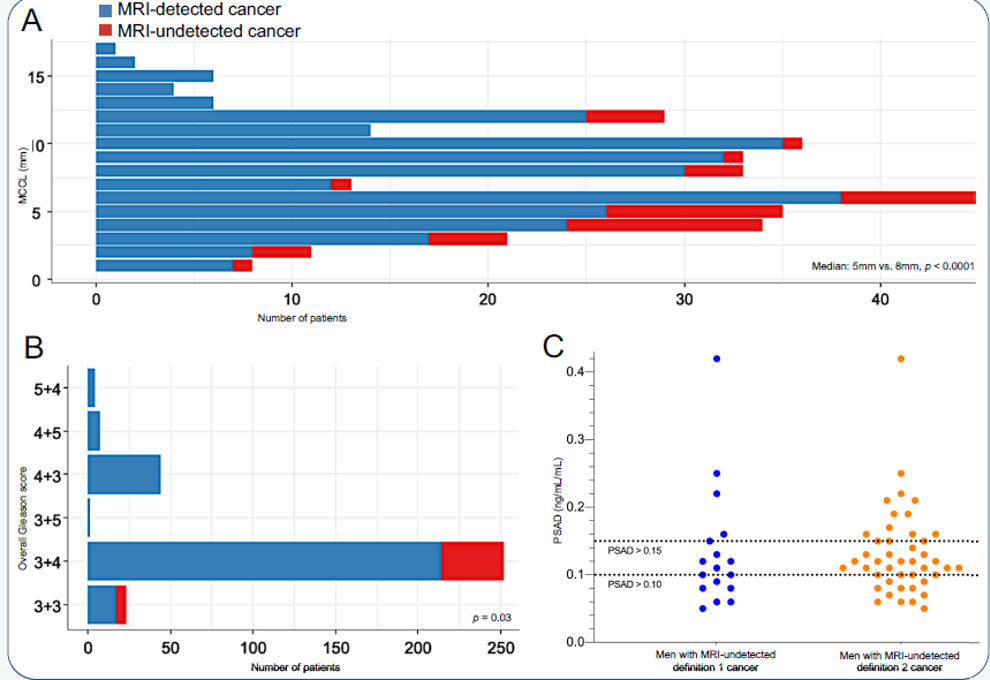The objectives of the presented study were to summarize cancer attributes of significant prostate tumors that are overlooked by multiparametric MRI. The authors also wanted to assess the utility of prostate-specific antigen (PSA) density thresholds to aid the detection of multiparametric MRI-invisible disease.
In the PROMIS study, multiparametric MRI and transrectal ultrasound (TRUS) guided biopsy were compared to 5-millimeter template mapping biopsy as a reference standard. The assessed outcomes included overall and maximum Gleason scores, cancer outcomes, maximum cancer core length (MCCL), and PSA density. Attributes were compared between cancers that were overlooked and those that were detected.
For significant cancer, two definitions were used:
- Definition 1 - Gleason score >=4+3 +/- MCCL>=6 mm
- Definition 2 - Gleason score >=3+4 +/- MCCL >=4 mm
Figure 1 demonstrates the comparison of attributes between detected and undetected cancer. Figure 1a shows maximum cancer core lengths, and Figure 1B shows overall Gleason scores, while Figure 1C demonstrates PSA density thresholds for both definitions of significant cancer. The blue bars demonstrate detected disease while the red bars demonstrate undetected disease. The blue dots represent significant undetected cancer according to definition number one, and the orange dots represent significant undetected cancer according to definition number two.
Figure 1 – Comparison of attributes between detected and undetected cancer:
When using definition one, 7% of the cancer was MRI undetected, and when using definition two, 13% of cancers were undetected with MRI.
When comparing these results to those of the transrectal ultrasound-guided biopsy with definition #1, 52% of cancers were undetected with TRUS, and when using definition #2, 40% of cancers were undetected with TRUS.
MRI undetected cancer had significantly smaller MCCL (5 vs. 8 mm, p<0.0001) compared to MRI detected cancer. MRI undetected cancer had also significantly lower overall and maximum Gleason score (p=0.0007; p<0.0001) compared to MRI detected cancer.
When using a PSA density threshold of above 0.15, this reduced the undetected clinically significant cancer according to definition number one to 5% (12/230). When using definition number two of clinically significant cancer, this reduced the undetected clinically significant cancer to 9% (30/331). With a PSA threshold of above 0.1, the percentages were 3% and 3%, respectively.
In this study, the authors concluded that few clinically significant prostate cancers are overlooked by multiparametric MRI. Undetected prostate tumors with MRI are of lower Gleason grade group and shorter cancer core length compared to MRI-detected disease.
Presented by: Joseph Norris, Medical Research Council (MRC), University College London, London, England
Written by: Hanan Goldberg, MD, MSc., Urology Department, SUNY Upstate Medical University, Syracuse, NY, USA, Twitter: @GoldbergHanan, at the 2020 American Urological Association (AUA) Annual Meeting, Virtual Experience #AUA20, June 27-28, 2020.
References:
- Ahmed HU, El-Shater Bosaily A, Brown LC, Gabe R, Kaplan R, Parmar MK, et al. Diagnostic accuracy of multiparametric MRI and TRUS biopsy in prostate cancer (PROMIS): a paired validating confirmatory study. The Lancet. 2017;389(10071):815-22.


